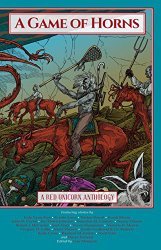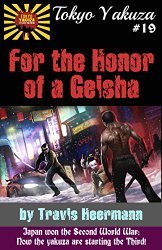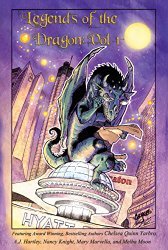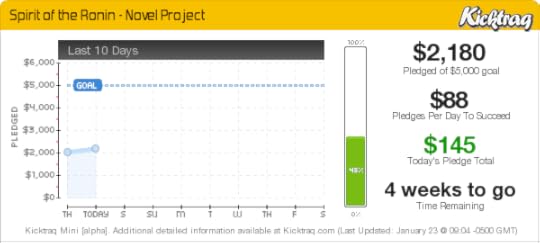Travis Heermann's Blog, page 12
December 10, 2015
Scenes: It Ain’t Just the Cliffhanger
This year, the editor of my Ronin Trilogy gave me an incredible compliment: “In Spirit of the Ronin, every scene does exactly what you intend it to do.” On a day when I was dreadfully worried about whether the newly finished draft of the novel was any good, this came at the perfect time.
I’ll quickly avert my gaze from the implication that apparently I didn’t quite hit that mark every time in previous books. Chalk it up to the learning process.
A lot of know-how about writing scenes is packed into this one sentence, and it comes in levels and/or number of trunk novels.
Level 1 (Chum/Sharkbait, 0 novels): “What’s a scene?”
A scene represents a discrete chunk of a narrative’s time wherein a mix of stuff appears: character interactions, things happening, background information delivery. Changing scenes is useful for switching characters, locations, or time. Shakespeare divided his plays up into acts and scene, and even numbered his scenes, so I should have scenes, too.
Level 2 (Remora/Shark Wannabe, 1 trunk novel): “I understand that scenes are a dramatically useful way of dividing up a story, but what do you mean you can use them to propel the plot?”
Scenes can propel the plot along if you can end them at compelling moments. Cliffhangers are the most obvious example of this, but not every situation is appropriate for them. Some scenes are more introspective, reactive. Sometimes in a scene, Things Happen. Sometimes, the Character Reacts to Things That Happened.
At this point, think of it this way. To propel the plot forward, end every scene with either a “Yes, but…” or a “No! And moreover…”
To build dramatic tension, the protagonist must be constantly striving and failing against the antagonist, who should always have the upper hand, until the final climactic moment when Everything Hangs in the Balance. You can have the protagonist occasionally succeed at some dramatic moment, but their success should be thwarted or minimized in some way by a worsening of the situation. This represents a “Yes, but …”
Every time the protagonist fails, the antagonist’s advantage is strengthened. Protagonist tries, fails… and then things get even worse. This is the “No, and moreover…”
The reader should leave every scene with a major dramatic question. This question makes them hunger to know what happens next.
Credit goes to Odyssey Writing Workshop’s Jeanne Cavelos for this wisdom.
Level 3 (Tiger Shark, 2 trunk novels): “I understand how to set up scenes with cliffhangers or dramatic questions at the end of each one, but what do you mean scenes have structure?”
The vast majority of stories in the Western storytelling paradigm are structured in three acts. Just like stories, scenes have a Three-Act Structure. Movies, novels, short stories, all have a Three-Act Structure (the nature of this is a whole other topic). For our purposes here, we can break scenes down into mini-acts, each representing the Beginning, Middle, and End of the scene.
Each scene follows one of two patterns.
Goal (what the character is trying to achieve is established at the beginning of a scene)
Conflict (the things against which the character struggles in the middle)
Disaster (the way everything goes to hell at the end of the scene, the cliffhanger)
OR
Reaction (at the beginning of this scene, character reacts to how things went to hell in the previous scene)
Dilemma (in the middle of the scene, the character is placed in an even worse situation)
Decision (at the end of the scene, the character chooses how to move forward)
This pattern is often called Scene and Sequel—a potentially confusing choice of jargon—developed by Dwight Swain in his book Techniques of the Selling Writer. This is not the same kind of scene as Level 1, nor does sequel mean the next movie in a series. Use of Scene & Sequel has become relatively widespread or at least familiar to most professionals.
Level 4 (Hammerhead, 3 trunk novels): “I understand how each scene needs to have a beginning, middle, and end, but do you mean each scene needs a purpose?”
During the revision process—not the composition process—ask the question: What is this scene for? What do I want it to accomplish? I say during the revision process because this is the kind of thinking that is not always helpful when you’re trying to open up your subconscious and let the story bubble out. This is too much thinking, not enough feeling. You may be skilled enough that it happens naturally, un-self-consciously, but if not, this is for the polishing phase.
An effective scene requires it to do at least three things from this list.
Advance the plot
Develop character
Develop the story’s world
Pique the reader’s interest for the next scene
If you’ve managed the previous levels, #4 is pretty much built in, so you only have to worry about the other three.
And if you can hit all four, every time, that makes you a Literary Effing Great White, and you’ve either passed beyond the Trunk Novel Stage to some serious publication—or you soon will.
Unlocking Levels Beyond
There are doubtless higher skill levels. Becoming a better writer is a lifetime pursuit of excellence. I have not yet unlocked the Mythical Megalodon and Literary Leviathan levels so I don’t know what revelations they contain. I am only vaguely aware of their existence, in the way I was only vaguely aware of the higher realms when I was Level 1 Chum.
One of the hardest parts of writing is not knowing—really not knowing—whether your work is any good. You have to believe it is, even if it might not be—and when you’re shown it isn’t that good, to find a way past this particularly hard knock and keep striving to get better. Keep studying. Keep practicing. Keep learning. It’s all any of us can ever do.
Apparently, unbeknownst to myself, something clicked with Spirit of the Ronin, and my editor saw it. Having someone point it out to you is like ambrosia on the parched soul. There wasn’t anything specific that I learned, or studied. My only explanation is that study and practice came together.
The hardest part is wondering when it will happen again.
[This article is a reprint that appeared first over at The Fictorians, on Dec. 3.]
November 4, 2015
Sword of the Ronin Featured in Historical Fiction Story Bundle
Sword of the Ronin meets nine other historical eras in this fabulous e-book bundle from Story Bundle: The Historical Fiction Bundle.
From Story Bundle’s website:
“History is made up of stories, and those stories are vast, and varied beyond compare. The Historical Fiction Bundle comprises a total of ten terrific titles by top-notch authors, together representing exactly this breadth and variety of experience. These stories blend real-world historical settings with romance, adventure, fantasy and mystery to bring you whole worlds of fun! You’ll visit ancient Egypt, the Americas, the Caribbean, Great Britain and Japan; you’ll meet pirates and warriors, witches and princesses, detectives, time-travelers and more.”
Pay what you like. Support yours truly and six other indie authors and support a worthy charity: Girls Write Now.
That sounds like win-win-win to me.
October 30, 2015
The Horror You Can’t See
As a writer who gravitates to the dark and desolate and desperate, I often inject a syringe full of horror into my stories. “You got your horror in my fantasy!” “Oh, yeah? You got your fantasy in my horror!”
This month, I’m going to talk about a technique that the best horror writers and filmmakers use masterfully—leaving things off-screen.
So before this wild assertion spurs someone to argue with me, someone whose tastes prefer everything upfront and in one’s face, let me say that I enjoy strategic splatter.
The human mind—especially that of a hard-core reader—possesses prodigious powers of imagination. I was reminded of this when I was writing Sword of the Ronin, the second book of my historical fantasy trilogy. A number of beta readers expressed some difficulty at getting through a scene where the hero, who has been tortured and imprisoned for some time, has no choice but to witness the execution of a fellow prisoner. My wife read that scene and told me that it was one of the most excruciating things she has ever read. She was quite surprised when I pointed out to her that everything in that scene had happened off-screen, so she went back and looked at it again. None of what happens in that scene is visible. The protagonist only hears things and sees indirect evidence of what’s happening. Nevertheless, it is a scene that sticks with a great many readers.
H.P. Lovecraft said, ““The oldest and strongest emotion of mankind is fear, and the oldest and strongest kind of fear is fear of the unknown.” His essay “Supernatural Horror in Literature” is where this quote appears, and is absolutely essential reading for anyone who wants to write scary stuff. He used this technique over and over again. So many of his most memorable beasties are terrifying because we can’t quite see them. In “The Dunwich Horror,” the creature is invisible. Ghosts scare us worst when we know they’re there, but we can’t see them. The monster in the shadows. The strange sounds in the night. The serial killer hiding among us. The guy next door keeping someone chained up in his basement.
You don’t want to use the clichéd, cheap jump from the cat jumping out the cupboard. You want the kind of tension that lets the audience keep squirming in their seats.
The bottom line is that we’re more afraid of what we can’t see than what we can. In the aftermath of a great horror book or movie, we remember the fear we felt during the experience, but don’t find the monster as scary anymore—because we’ve seen it.
Should you keep everything off-screen? You certainly can. It’s an artistic choice; some audiences prefer their horror a bit more sedate. But you don’t have to.
Allow me to point toward one of the most effective horror movies of recent years, The Descent, which tells the story of six women exploring an unmapped cave. This movie is an incredible mix of both on-screen and off-screen horror. First of all, it’s in a cave, so unless the flashlights are on, the screen is pitch black. On top of the incredibly claustrophobic environment (it was often a wonder to me how this was filmed), tension is built by half-glimpsed somethings at the edge of the light, or by strange sounds in pitch blackness. Throughout much of the film the horror is barely glimpsed, suggested, implied. But then at a certain point, the flood-gates open, the gloves come off, and we are drenched in blood, ichor, and violence. It was one of those movies that’s so effective at what it set out to do that I don’t think I want to see it again.
Like all tools—from paintbrushes to tack hammers to prepositional phrases—it’s the artist’s craft that decides when to use it to achieve the desired effect. Sometimes you need the splatter, the dripping fangs, all eight of the giant spider’s luminous eyes in hairy close-up. But those are often best used as part of the Big Reveal, the Climax, the Gruesome Finale. Sometimes, you need the shadows, the invisible threat, the last glimpse of a foot being dragged around a corner, the knife that wasn’t where you left it, the sound of something slithering through underbrush, to crank up the tension. Prime the audience with unrelenting tension so that the Big Reveal produces an audible gasp.
September 22, 2015
Short Stories Galore
It’s strange how a writing career propagates in waves. Just by timing and random chance, I have a whole raft of short stories coming out now and in the near future.
“The Metal of a Man” appears in this month’s Electric Spec magazine. What does an aging cyborg do when he knows that parts of his body will outlive him?
“Aisa’s Beast” appearing in Legends of the Dragon, Vol. 1. (Trade paperback edition available soon.) A strange, subterranean creature is drawn to a gaudy pageant of strange mortals called Dragon Con, where he is enslaved by a cruel Faerie princess.
“For the Honor of a Geisha” came out in an anthology called Tokyo Yakuza. (Available either as short story or whole anthology.) A yakuza cyborg must transport priceless data through the territory of an enemy gang. Little does he know the lengths they will go to steal it.


[image error][image error]
 “The Sharpest Horn” appearing in A Game of Horns. A young woman struggling with reality and mental illness is imprisoned by her parents, until a blood-red unicorn comes to her “rescue.” A Game of Horns is a charity anthology benefiting the Don Hodge Memorial Scholarship Fund.
“The Sharpest Horn” appearing in A Game of Horns. A young woman struggling with reality and mental illness is imprisoned by her parents, until a blood-red unicorn comes to her “rescue.” A Game of Horns is a charity anthology benefiting the Don Hodge Memorial Scholarship Fund.
“Screaming Without a Mouth” will appear in the March 2016 issue of Apex Magazine. A guilt-ridden school-girl despairs the suicide of her friend, until she discovers that her friend still exists, but in a terrible new form.
“The Girl with No Name” will appear in an upcoming issue of New Myths magazine. A Filipina immigrant girl in modern-day Japan uncovers the supernatural truth behind a gang of thieves, and they discover her as well.
“Branches of Infinity” will appear in Weird and Wondrous Work from World Weaver Press. A linguist studies the strange effects of an alien phrasebook that could literally change the whole world.
“Where the Devil Resides,” a dreadpunk novella, will appear in the next issue of Alembical by Paper Golem Press. In an alternate-history American South ravaged by a Civil War that went on far too-long, a Yankee minister must save his daughter from the clutches of the notorious swamp rat, “Smilin'” Jack Welch. What he discovers in the Everglades takes him farther down the river of human darkness than he thought possible.
“Demon-touched” will appear in March, 2016, in Fiction River: Visions of the Apocalypse. In a world gone mad, a lone neuroscientist struggles to find the cure for a plague of demon-possession.
“Death Bunnies of Toxic Island” will appear in May, 2016, in Fiction River: Last Stand . Haley loves everything about bunnies. When her bunny is horribly slain right in front of her, she must go on a quest to assuage her shattered well-being. And where to? An island full of cute, fluffy bunnies–that won’t be just bunnies for much longer…
“The Ballad of Osmosis McGuire” will appear in July, 2016, in Fiction River: Superpowers. A high-school student discovers that he has the ability to steal strength, intelligence, and dexterity from other people. But then a girl walks straight out of his dreams and things go terribly awry.
“Redline”, a story that Kristine Kathryn Rusch described “an incredible piece of writing, a story that will stick with you”, will be appearing in November, 2016, in Fiction River: Pulse Pounders–Adrenaline . Three rednecks, one ex-Navy SEAL, one pit bull, and two thundering muscle cars in a desperate chase to the end of the line.
So, yeah. I’ve been busy.
 It’s been a good year so far on the short story front.
It’s been a good year so far on the short story front.
August 25, 2015
A Compilation of Elsewheres
I am terribly remiss. My neglect for this blog is something I often lament. I never post here often enough. I harangue myself with guilt. And I still post here but rarely.
Why?
Because I’m writing for other blogs, and I only have so much time. Yes, I’m well aware that the sense of this is … wonky.
So I thought I would share here links to stuff that I’ve been writing for the Fictorians, a group of fellow writers that talks often about the writing life. I hope you’ll check some of these out, as well as the work of the other fantastic authors on the Fictorians page.
The Critique Group Waltz — Is Yours in Step? – August 26, 2015
Mining the Pain – July 15, 2015
Convention Selling Tips – June 09, 2015
A Killer Combo for Writers: Dropbox + Scrivener – May 19, 2015
Examinations and Bindings – February 12, 2015
Cracking the Whip, but Not Too Hard – December 29, 2014
The Literary Marriage — Agent and Author – October 17, 2014
Three Aliens Walk into a Writers Retreat – April 17, 2014
Relax, and Dial Back the Desperation – September 13, 2013
June 16, 2015
Spirit of the Ronin — Pre-order now!
 A climax sixteen years in the making…
A climax sixteen years in the making…
Coming in e-book formats on June 24th, 2015. (Print versions coming in late July.)
Available for pre-order now on:
Kindle
Nook
Kobo
Apple
A CLASH OF HONOR, LOVE, AND AMBITION
In thirteenth-century Japan, the ronin Ken’ishi’s fondest wish has been granted—he has found service with a powerful samurai lord.
But the underworld crime boss known as Green Tiger lurks in the shadows of Lord Tsunetomo’s retinue, and Ken’ishi’s honor is tested when learns his new master is married to Kazuko, the only woman he has ever loved. His unknown lineage holds dangerous secrets that could destroy him, and only his sword, the magical relic called Silver Crane, holds the key to his past…and his future.
With enemies, temptation, and strife assailing him on all sides, Ken’ishi’s very soul falls into jeopardy—even as Khubilai Khan’s Mongol hordes plot their next attack.
Can Ken’ishi defeat Green Tiger, defend his homeland from the barbarian invaders, and remain true to his heart, his lord, and his honor?
If you love romance, intrigue and action on an epic scale, don’t miss this stunning climax to the Ronin Trilogy.
“When you actively watch out for new writers with potential, every so often you’re pleasantly surprised by one who has simply Got It, whose work is ready to push up to the next level. Travis Heermann has simply Got It.” – James A. Owen, author of Here, There Be Dragons
“Lovely details, an honorable character, and great action. Travis Heermann’s Spirit of the Ronin is a rich and entertaining story.” – Kevin J. Anderson, New York Times bestselling author of Blood of the Cosmos, the Jedi Academy Trilogy, and The Last Days of Krypton
May 20, 2015
Denver Comic Con – A Memorial Weekend of Geekery
The upcoming Memorial Weekend in Denver will see me once again at Denver Comic Con. This is without question the biggest event in the neighborhood, expecting 60k+ fans, and a celebrity guest list that’s a Who’s Who of geek TV and films. I’m delighted to be a part of this huge event. I’ll be manning a booth again in the exhibit hall with my friends from Evil Brain Trust, Ltd., Guy Anthony DeMarco, Tonya DeMarco, Quincy J. Allen, Mario Acevedo, Catherine Schimming, and Kathryn Renta.
It’s gonna be a busy weekend, with seven panels. Here’s my schedule. Look for me here or in the Evil Brain Trust booth!
Saturday
Tales from the Slush Pile – 12:55-1:45 – Room 205
The Better Half: Sidekicks in Fiction – 2:30-3:20 – Room 203
En Garde!: Writing Action Scenes – 3:40-4:30 – Room 203
Sunday
Sticking the Landing: Ending Your Story – 12:55-1:45 – Room 205
Monday
Going Down the Research Rabbit Hole – 11:45-12:35 – Room 205
There Will Be Blood – 2:05-2:55 – Room 205
Wish You Were There: Worldbuilding – 4:25-5:15 – Room 402
March 17, 2015
A Bundle of Awesome
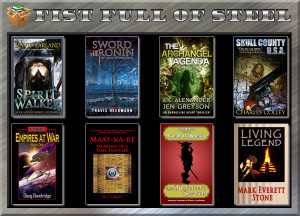 I’m delighted to announce that in the run-up to the release of Spirit of the Ronin this summer, Sword of the Ronin is appearing in a bundle of ebooks with some amazing indie authors.
I’m delighted to announce that in the run-up to the release of Spirit of the Ronin this summer, Sword of the Ronin is appearing in a bundle of ebooks with some amazing indie authors.
This bundle is called FIST FULL OF STEEL, and here’s the best part: you can name your price!
Urban fantasy? Check.
Historical fantasy? Check.
Thriller? Check.
Historical adventure? Check.
Space opera? Check.
Epic fantasy? Check.
This is a great way for you to support independent artists like myself and these fine folks. Please give this a look. This smokin’ deal disappears on April 5, 2015.
February 9, 2015
Spirit of the Ronin Kickstarter FUNDED!!!
Woohoo!
*does happydance*
See the post immediately below this one for current tally.
Next, we’re shooting for Stretch Goals to add additional artwork, perhaps another short story….
BANZAI!!!!
January 22, 2015
A Heartstopping New Project
 Well, at least it’s heart-stopping for me. It’s been pretty quiet around these parts, as I tend to devote myself more to production and development of fiction than actually blogging.
Well, at least it’s heart-stopping for me. It’s been pretty quiet around these parts, as I tend to devote myself more to production and development of fiction than actually blogging.
But I want to announce that the Time has come for the Book 3 of the Ronin Trilogy.
The Kickstarter campaign for Spirit of the Ronin launched today, Thursday, January 22nd.
Here’s a link to the Kickstarter.
This is the culmination of a story fifteen years in the making. The Ronin series has been a work of passion for me since 1999, a story that changed my life, and now it’s finally time to finish the story.
And with your help, we’re going to make something cool!
But here’s the thing:
Kickstarter campaigns live and die by momentum, or the lack thereof. Here are a few statistics.
Kickstarter campaign success rate for publishing projects: 30.9% (this is down about 12% from two years ago, due to increasing competition).
79% of projects that raised more than 20% (in our case $1,000) of their goal within the first week were successfully funded.
90% of projects that raised more than 30% (in our case $1,500) of their goal within the first week were successfully funded.
The percentages show that once a campaign gets initial traction, it is most likely to be carried to successful conclusion. These statistics rely on campaigns building momentum early, like within the first week. Much like a duel between samurai, the quickest to the cut often wins.
You can be part of that momentum, that initial push that blasts it across the finish line.
People who enjoy contributing to Kickstarters sometimes want to ride in at the last minute and push the campaign past the finish line. If that’s your thing, I love you, please do. Or maybe you need to wait on a paycheck. That’s cool too. Rent and food for the kids come first. But there’s a way you can help with early momentum and fulfill your desire for that last minute cavalry charge: Kickstarter lets you change your pledge. Even if you plan to pledge for a larger reward package near the end of the campaign, it is still really helpful of you could pledge $10.00-25.00 at the beginning, and then change your reward level later. (Remember that nothing gets charged to your account unless the campaign funds successfully.)
Aside from financial support, the next biggest thing you can do is to tell people about this. Surely you have friends and family that might enjoy the story. Facebook, Twitter, Google+, Pinterest, word of mouth in coffee shop, whatever your preferred method, your personal outreach could be the one that pushes the campaign to critical mass.
The next month is going to be a roller coaster with a 150-ft. vertical loop and 90 mph drops, which is to say, gut-wrenching + terrifying + awesome.
Please help.
Thank you.
Want to see how the project is going? Check this out.


